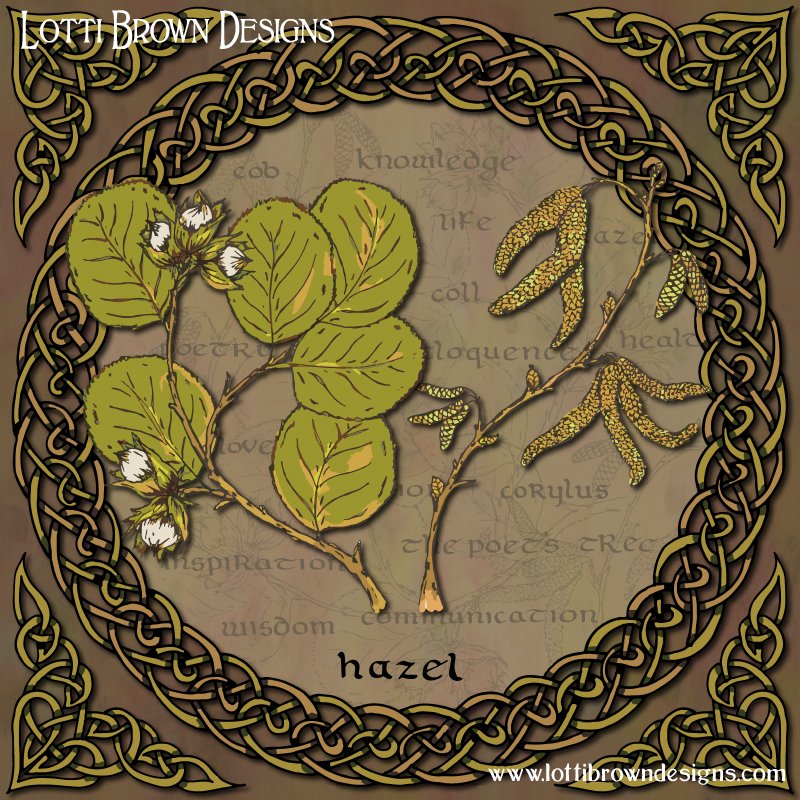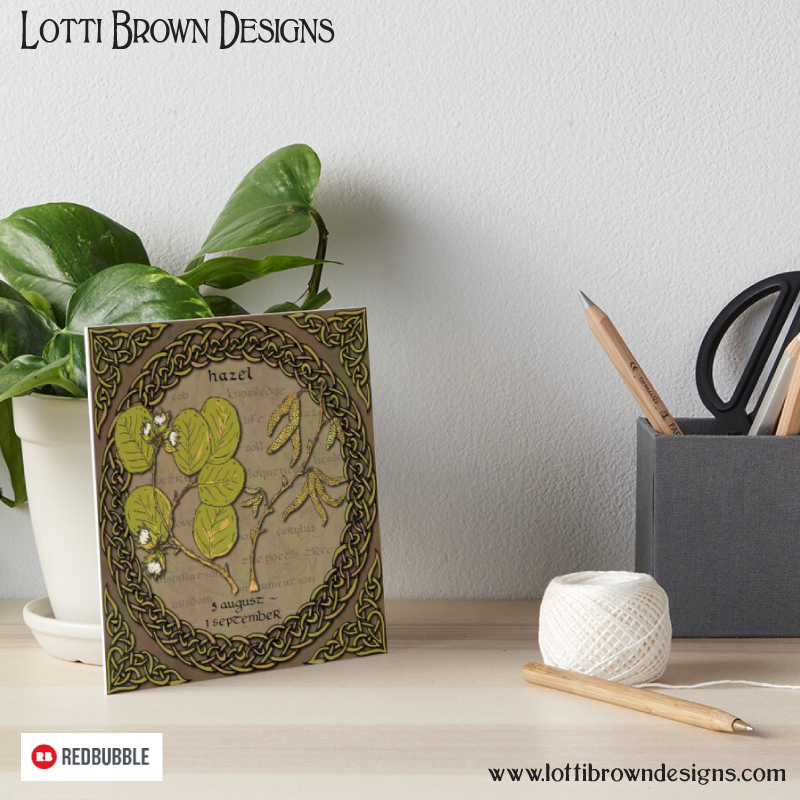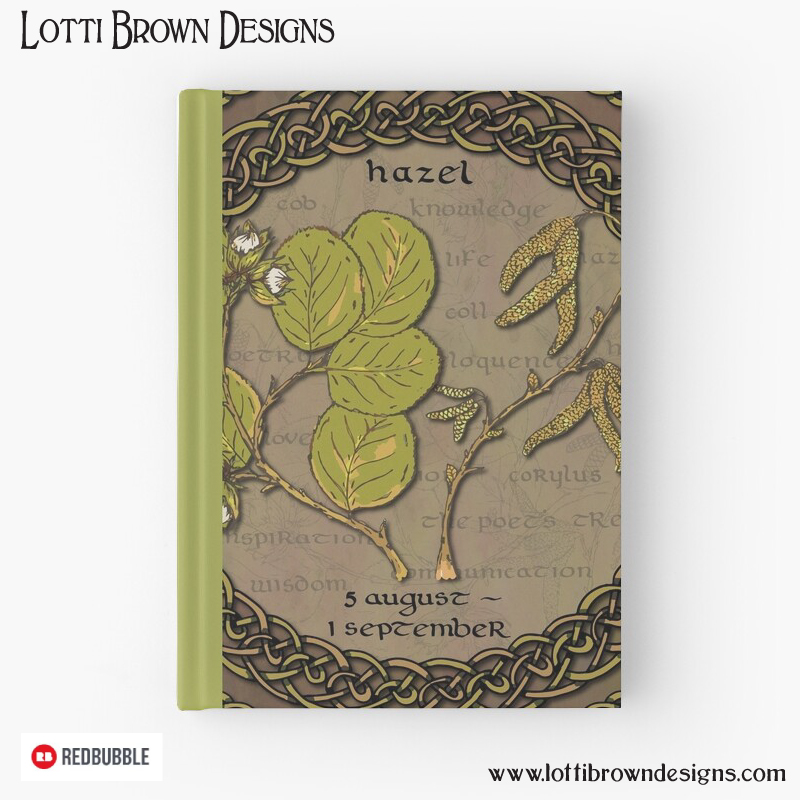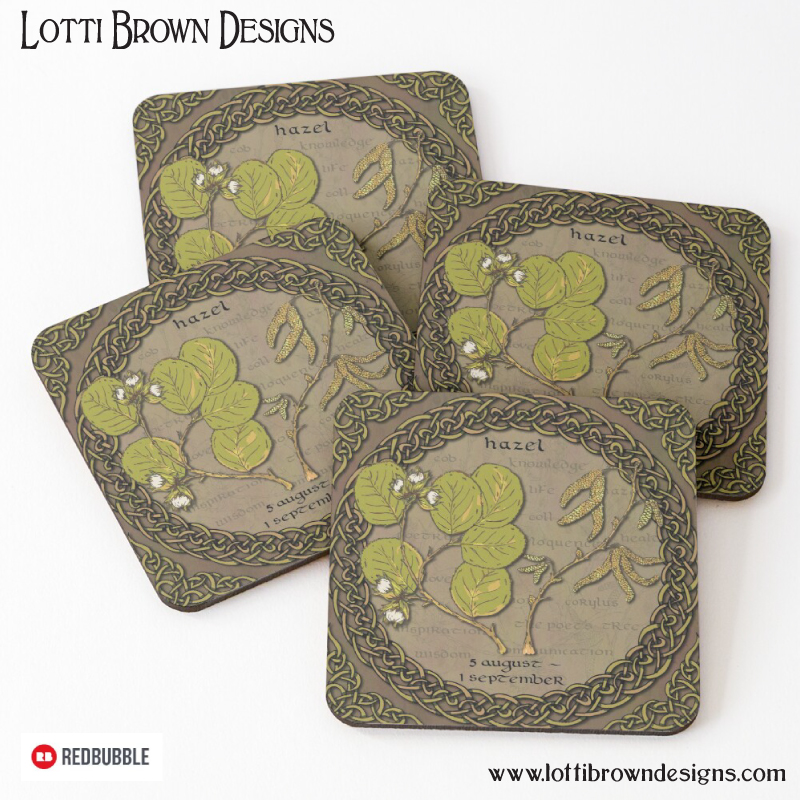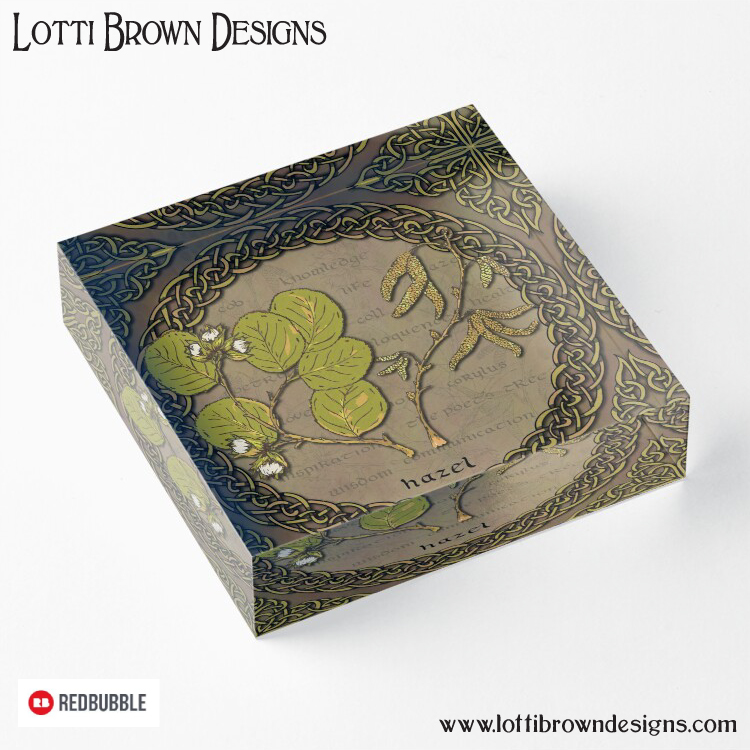*** IMPORTANT - I'm retiring my digital files - SVG/PNG/DXF/EPS - and printables from 31st December 2025 ***
*** Please ensure that you have everything you need - files and/or instructions printed off from the website (find them currently in the ARCHIVES section) - by 31st December 2025 as they will not be available after this date ***

Hazel Tree Symbolism &
Celtic Hazel Art
Learn about hazel tree symbolism, myths and meanings as I share my Celtic Tree Calendar hazel art...
The hazel is one of our most ancient trees and its a tree we're very familiar with, being a tree of hedgerows, and as such it does have an important history and role in our society, culture and folklore...
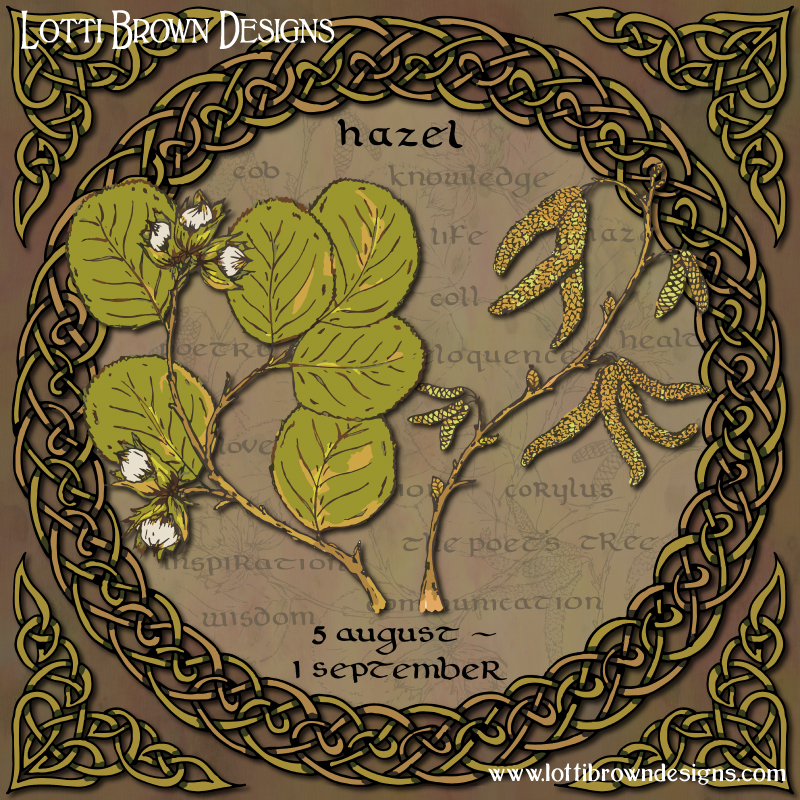 Hazel Celtic Tree Calendar month - 5th August to 1st September
Hazel Celtic Tree Calendar month - 5th August to 1st SeptemberThis is part of my Celtic Tree Calendar art project which I did through 2021 - find out more about that here - and find out all about what the Celtic Tree Calendar actually is here!
 Hazel tree art print
Hazel tree art print(undated)
Buy my Celtic tree calendar hazel art print here
(with date of the Celtic tree calendar month of the hazel - 5th August to 1st September)
Hazel Tree Symbolism, Myths & Meanings
The hazel is a small tree, most often seen in hedgerows these days, and much different in stature than a mighty oak – but in its own way, no less important…
Hazel has been an extremely important tree for hundreds if not thousands of years – and has been of great use to humans.
Hazelnuts have been found, often roasted, in prehistoric hearths, middens (rubbish piles), and even tombs.
Hazel
- Latin name: Corylus
- Irish/Gaelic name: Coll
- Common names: Cob
- Celtic tree calendar: 5th August to 1st September
- Qualities: Healing, wisdom, knowledge, protection, inspiration, divination, understanding, love,
- Associations: The Poet’s Tree, Tree of Knowledge, Mercury/Hermes, Brigid, Fionn mac Cumhail, air, salmon, dowsing, wands, poetry, snakes,
 Hazel tree
Hazel treeA Useful Tree
Hazel is a vigorous grower and the long stems of hazel are regularly ‘coppiced’ – cut down to the ground.
The stems (also known as ‘rods’) are used for all kinds of practical purposes – and the long hazel rods will have grown again by the following year, so the wood is simply harvested from the living tree in a sustainable manner. This is the way that humans have used the hazel for thousands of years.
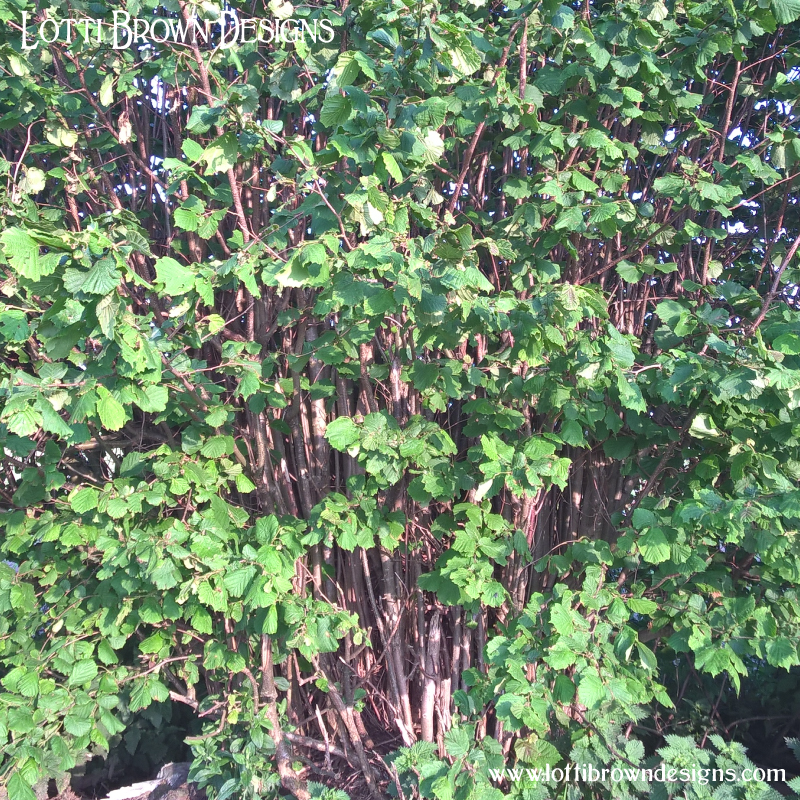 Coppiced hazel tree with many young stems growing from the base
Coppiced hazel tree with many young stems growing from the baseThe hazel stems are used for beanpoles, walking sticks, hoops, hurdles, hedge-stakes, for basket-making, as beaters, as thatchers’ ‘springels’ and to make ‘coracles’ (small, flat-bottomed boats).
We know that the Romans used supple hazel twigs to tie vines to wooden stakes.
In the Middle Ages, hazel was burnt for use as charcoal – and in the late 13th century, a monk, Roger Bacon, invented a recipe for gunpowder using charcoal from hazel (or willow) mixed with saltpetre and sulphur.
The hazel rods were also often used for divining – we’ll look more at this, later…
What's in a Name?
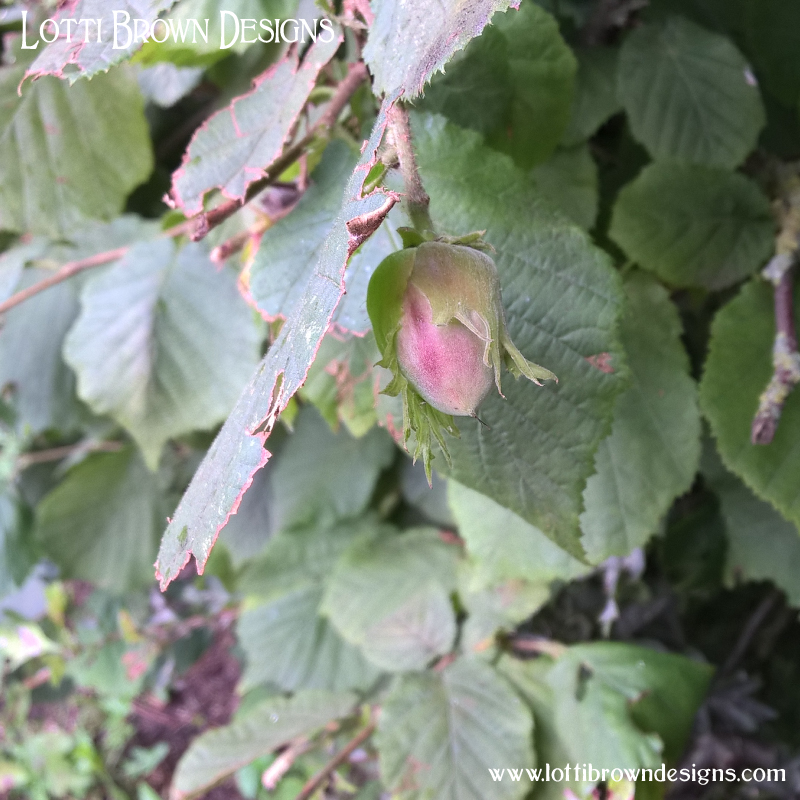 Hazelnuts
HazelnutsThe Latin name for hazel is ‘Corylus’. This is because the leaves around the hazelnut look like a style of helmet called ‘Korys’ – so the Corylus is called ‘the helmeted one’.
Scotland may actually be named after the hazel. Caledonia, the old name for Scotland is thought to derive from ‘Cal Dun’ – ‘the hill of hazel’ – signifying how widespread the tree once was in this area.
A Tree of Great Importance
In Ireland, the 17th-century priest, Geoffrey Keating, writes in his ‘History of Ireland’ of an early king, Mac Coll, meaning ‘Son of hazel’ – who was one of the last kings of the ancient gods, known as the Tuatha de Danaan.
The 9th-century ‘Triads of Ireland’ write that the felling of hazel carried the death penalty. Hazel was one of just two trees that carried this punishment (apple was the other) – showing just how important the tree was to society at the time.
In the medieval Irish ‘Dindsenchas’ (or ‘Dinnseanchas’ – meaning ‘topography’ or ‘lore of places’) the hazel is associated with the ‘Great Mugna’ tree, ‘Eo Mugna’ – one of five legendary, ancient trees in Ireland.
 Hazel tree
Hazel treeThe Great Mugna was a yew or oak tree that bore apples, acorns, and hazelnuts from its branches. The Great Mugna tree was said to have been a descendant of the Tree of Knowledge from the original Garden of Eden and represented the virtues of beauty (apples), wisdom (hazelnuts), and strength (acorns).
Tree of Wisdom
The hazel was historically seen as the Celtic Tree of Wisdom or Knowledge…
The Dindsenchas tells us of a sacred well of life, Connla’s Well (Ireland – also known as Nechtan’s Well or the Well of Segais). Here, alongside the Great Mugna tree, grow nine hazel trees which overhang the well -
“a beautiful fountain over which nine hazels of poetic art produced flowers and fruit simultaneously.”
The number nine seems connected to hazels – hazel is also the ninth ogham letter.
The hazelnuts, which were thought to contain all wisdom (known as ‘awen’ or ‘imbas’), dropped into the water and were eaten by the salmon swimming in the pool. The bright spots on the side of the salmon showed how many hazelnuts the salmon had eaten.
The salmon was thought to be the oldest and wisest of all the animal spirits and was known as the ‘Salmon of Wisdom’ or the ‘Salmon of Knowledge’.
 Salmon of Wisdom
Salmon of WisdomThe salmon would swim out to sea, to transmit its knowledge to the other salmon – the Salmon of Knowledge is the father of all salmon – and then returned to the well of knowledge, and then migrating between well and sea.
To eat the hazelnut was highly desirable in order to gain the precious wisdom it contained – and the hazelnut was known as the ‘food of the gods’.
Celtic druids, seers, and poets wished to eat the hazelnut or the salmon to gain the knowledge…
The Celtic hero Cuchulainn called hazel “the sweetest of woods”.
The Celtic story of Fionn mac Cumhail tells us of the boy Fionn, a pupil of the druid poet Finegas (or Finn Eces). Finegas spent seven years fishing for the salmon of knowledge so that he could eat it and gain the knowledge of ‘everything that was happening in Ireland’.
When he finally caught the salmon, he asked his pupil, Fionn, to cook the salmon but not taste it…
Fionn burnt his thumb on the salmon, while cooking the fish, and put his thumb straight to his mouth – so it was Fionn that gained the wisdom of the salmon, and not his master.
Throughout his life, Fionn would put his thumb to his mouth to access the magical wisdom.
Fionn also had a magical shield cut from a hazel tree. The shield was called “the dripping ancient hazel” because the head of the god Balor of the evil eye had hung from the hazel tree, dripping powerful poison onto it.
Scottish legend has a similar story of two mystical, sacred fishes who guarded a sacred well where the hazel trees grew. To kill or eat the fish would be punishable by the gods…
 Hazelnuts were believed to contain wisdom which could be acquired by eating the nuts
Hazelnuts were believed to contain wisdom which could be acquired by eating the nutsIn Scotland, hazel was one of the nine sacred woods gathered for the Beltane fires.
In Celtic legend, the hazel is associated with Oengus mac Og – the Celtic god of love and eloquence who carried a hazel wand.
Oengus called the hazel ‘friend of cracking’ meaning the hazel could help us ‘crack’ our habitual programming to gain inspirational flow and to access the wisdom of the gods.
He also called hazel ‘friend of nutshells’ – enhancing our understanding until we have it ‘in a nutshell’.
Irish heralds used to carry hazel wands as symbols of being under the protection of Oengus, god of love and eloquence.
In a druidic incantation or ritual for bards and poets called the ‘Diechetel do Chenaib’ (literally ‘cracking the nuts of wisdom’), it is thought that hazelnuts were chewed to bring about poetic or magical inspiration and insight. Hazel became known as ‘the poet’s tree’.
In Wales, hazel was sometimes sewn into sleeping caps to bring pleasant dreams and inspiration. And caps were woven from hazel twigs – to be worn as ‘thinking caps’ or ‘wishing caps’ to bring inspired thought and good fortune.
In the south-west of England, the hazel was said to be surrounded by silver snakes around its roots, giving the tree its special life force – an ability to understand all, swiftly, and to understand all connections.
Through this, hazel is connected to the god Mercury (Hermes) – the god of communication and knowledge. Hermes/Mercury carried a hazel staff, with ribbons or intertwining silver snakes – which became the caduceus symbol used by healers.
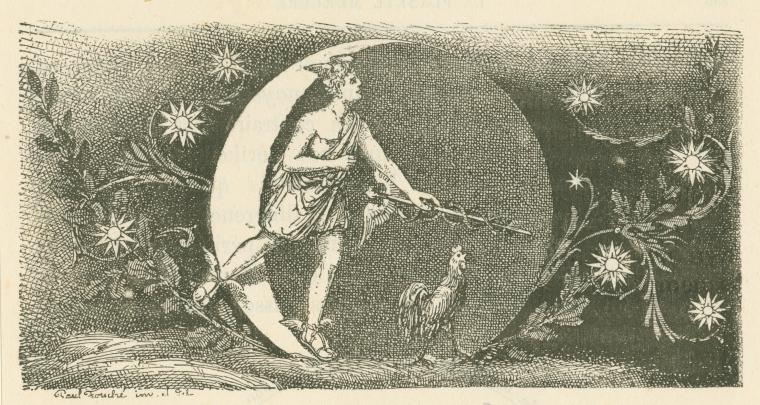 Mercury/Hermes carrying his hazel staff with intertwining silver snakes - credit: New York Public Library
Mercury/Hermes carrying his hazel staff with intertwining silver snakes - credit: New York Public LibraryThe Magical Tree
Hazel was believed to have magical qualities. Rods cut from hazel were used for dowsing – divining for water, minerals, or magical ley-lines (known, rather excitingly, as ‘dragon currents’), as well as for thieves, murderers, treasure, or simply lost objects.
A forked hazel branch was often used by dowsers – representing the forked tongue of the snake, or perhaps the dual aspect of life and death, which the hazel also symbolises (more on this in a bit!)…
But hazel branches should only be cut with the tree’s permission – and hazel rods cut on Midsummer’s Eve were the most powerful.
“Wishing wands”, seen in Teutonic myths, were cut from hazel. It was said that to cut a hazel wand, you should find a tree that’s not yet fruited, and using a ‘magical sickle’, cut a branch in a single stroke, at sunrise on a ‘day ruled by Mercury’ (a Wednesday).
Druids carried hazel rods, thought to be used to gain inspiration, to divine magical places, and possibly to be used as a kind of ‘talking stick’.
 Hazel stems
Hazel stemsHazel was also used to acquire invisibility “as if we had eaten fern-seed”. The 15th-century ‘Book of St. Albans’ (dated 1486) describes an invisibility spell – “carrying a hazel rod a fathom-and-a-half long [about 2m/9ft], and by inserting a green hazel twig into it in a particular manner.”
It is thought that hazel could give the ability to see fairies – and Shakespeare writes of the Queen of the Fairies, Queen Mab:
“Her chariot is an empty hazelnut,
Made by the joiner squirrel, or old grub,
Time out of mind the fairies’ coach-makers.”
From Romeo & Juliet
But perhaps one should take great care with the hazel tree and hazel nuts…
It was believed that a girl who went to gather hazelnuts on a Sunday would ‘meet the Devil’ and ‘find him holding her nutting bag’ – and as a consequence, also find herself pregnant by the Devil on her wedding day! An evil we hope befalls no-one!
Tree of Love
Becoming pregnant by the devil aside, the hazel tree was actually a tree of love.
In Ancient Rome, hazel torches were lit on the wedding night to ensure a happy marriage.
And in Devon, brides would be met from church by an old lady carrying a basket of hazelnuts, for luck.
Hazel was also associated with fertility – a Somerset saying quotes, “Plenty of catkins, plenty of prams”.
 Hazel catkins
Hazel catkinsA good year for hazelnuts was said to be a good year for babies.
There were also plenty of love spells using hazelnuts…
Young girls would name hazelnuts after potential suitors and then throw them into the fire. The nut that burnt with the loudest bang and brightest flame would be the ‘winner’.
At Halloween, the nuts were laid in the embers of a fire to find out whether a relationship was true love:
“If you love me, pop and fly,
If not, lie there silently.”
A pair of nuts could also be floated in water to see if they moved closer together or further apart. Two hazelnuts that remained side by side signified that lovers would be faithful – moving apart would signify faithlessness.
Catkins would be wrapped in pink or green cloth and worn close to the heart, before burning both fabric and catkins together, while reciting a love spell.
And if a girl could tie a knot in the fibre growing around the hazelnut, it was said she would be sure to marry.
 Hazelnuts
HazelnutsTree of Life and Death
Hazel is connected with Brigid, the Celtic goddess of poetry and home. Brigid keens the death of her son in the tale of the Battle of Moytura – hazel helps communication between the world of the living and the world of the dead – the ritual of ‘keening’ or mourning.
The old Irish/Gaelic name for hazel is ‘calltuinn’ meaning ‘the loss of something’ – hazel is used for understanding, communication, and the connection of our dual aspects of life and death.
 Hazel leaves and nuts
Hazel leaves and nutsTree of Health and Healing
The hazel tree was not used in herbal medicine to the extent of other trees like willow but hazelnuts are very nutritious, being rich in vitamins B and E, many minerals, and healthy fats, and are used in health and healing. The wood has also been used in folk remedies.
Hazelnuts were often ground down to help clear coughs (mixed with mead or honeyed water) and also to get rid of fevers, diarrhea, and to help ease heavy periods.
It was thought that toothache could be cured by holding a cross of hazel wood against the pain. A hazel-wood cross could also be used to draw the pain from adder bites.
And it was thought that carrying a double hazelnut in your pocket would help prevent toothache.
Hazel wood was also used for mouth ulcers, teething troubles, eczema, and acid reflux.
Scottish children born when hazelnuts were ripe on trees were given ‘milk of hazelnut’ for their health and for luck. Hazelnut milk mixed with honey was given to any babies who did not grow hale and hearty.
As a flower essence remedy, hazel is used to break free of old patterns and open the heart and mind to new inspiration, bringing wisdom, stability, and clarity of communication.
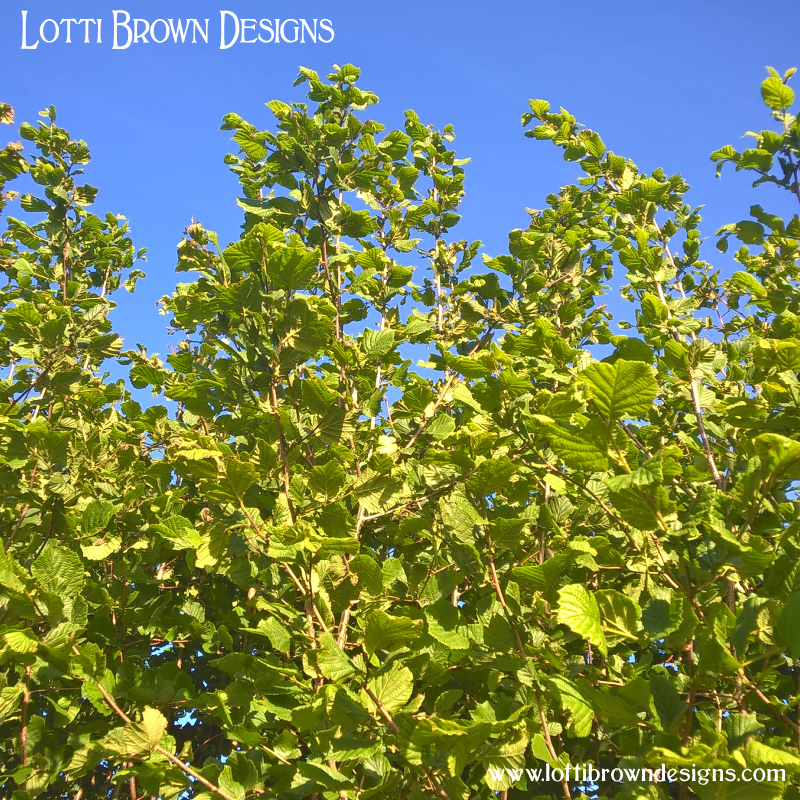 Hazel
HazelTree of Protection
Hazel was a protective tree – a tree to bring luck, and protection from storms and witchcraft in particular.
Hazel twigs or a double hazelnut could be carried in a pocket to bring luck and protect against witches - witches could be shot and killed with a double hazelnut, but not an ordinary bullet.
Hazelnut necklaces were also supposed to bring luck.
To protect against fairies, serpents, ‘evil spirits and evil hands’, you were advised to draw a circle around yourself with a stick of hazel that has been cut before sunrise on May Day.
A hazel stick could also be used to ritually shake ferns before gathering fern-seeds (fern-seeds were associated with fairies, magic, and invisibility).
Hazel twigs made in the shape of a cross were also thought to protect against witches and could be put in the fireplace of the home to protect – while a hazel charm of a heart between two crosses was placed in freshly-dug earth in the garden each spring.
Catkins around the hearth were believed to help sheep at lambing time, and horses were protected from fairies by being given a breastband of hazel to wear.
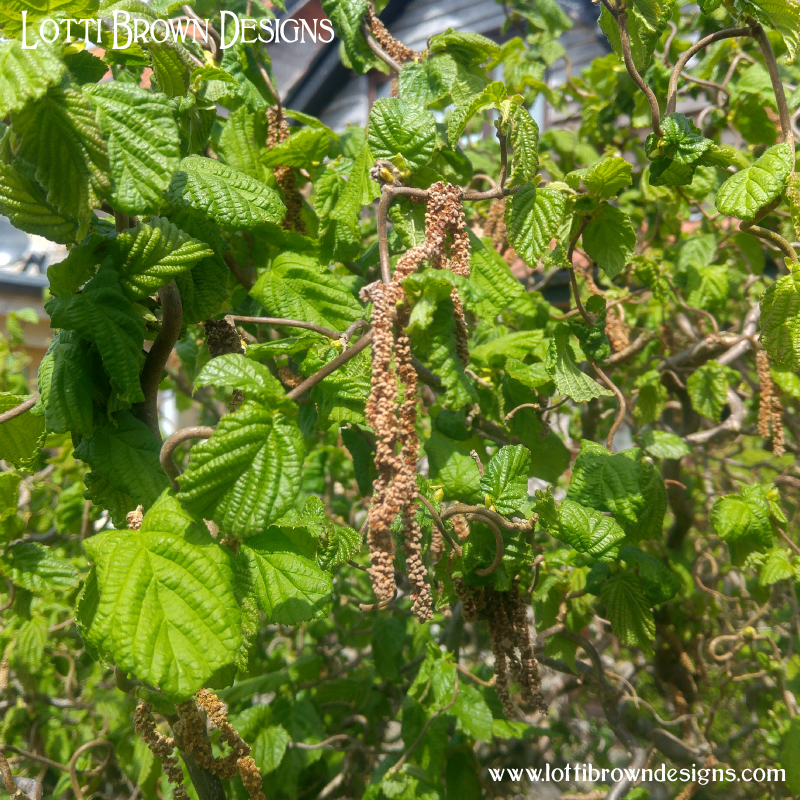 Catkins
CatkinsA horse which had over-eaten could have its legs and feet bound to hazel rods and words of magic were whispered into its ear - words known only by the Romany and the Ploughmen’s Guild.
In Ireland, cattle were driven through Beltane and Midsummer fires and their backs were singed with charred hazel rods to protect them from fairies. The hazel rods were then kept as droving sticks for the rest of the year.
A sprig of hazel by the door of a home, or on a windowsill or by a window-opening, was supposed to be able to protect against lightning – and hazel twigs gathered on Palm Sunday were thought to guard against both lightning and fire…
Whilst three hazel pins struck into the doorpost or wall of a house were believed to protect against fire and would alert the inhabitants to danger.
Plaited and woven hazel caps were worn by Welsh sailors to protect from storms at sea.
And it was advisable to stir jam with a stick of hazel to ensure the fairies wouldn’t steal it.
It was also said that Saint Patrick used a hazel stick to drive the snakes out of Ireland.
Hazel Tree Meaning
The hazel is the Celtic Tree of Knowledge, the Poet’s Tree, a magical tree, and tree of fairies.
It’s a tree of wisdom, of understanding and connection, and a tree of clear communications.
It’s a tree of life and death, bridging the worlds and enabling connection and communication between the worlds – a tree of health, healing, and protection – and a tree of love!
Hazel meaning is about knowledge, wisdom, inspiration, eloquence, and connection.
Celtic Hazel Tree Art
 Hazel drawings
Hazel drawings Hazel calligraphy
Hazel calligraphyI created two versions of my Celtic Hazel art - one with and one without the Celtic Tree Calendar dates for the hazel (5th August to 1st September):
- Undated version
- Dated version (5 August - 1 September) - great for birthdays, anniversaries etc
Both the dated and undated versions are available from my Redbubble store as art prints (framed and unframed), notebooks and journals, mugs, throw pillows and blankets, silky scarves, phone cases, tech cases, T-shirts and sweatshirts and lots more...
Here's a little taster - you can click on each image below to be taken directly to the item, or browse everything available via the two links above (dated/undated), and also at the bottom of the page for your convenience...
Please be careful to select the correct version that you prefer - all items are available in both versions, so if in doubt, please select from one of the main dated/undated links and browse individual products from there!
How to Buy
Please remember there are two versions of my Celtic Hazel artwork - the standard version (no dates) and the Celtic Tree Calendar version with the dates for the Celtic Tree Calendar month of Hazel (5th August to 1st September) - use the links here or just below to explore everything available in that version to find the print or product you want...
Read more about the Celtic Tree Calendar here....
See more of my Celtic Tree Calendar artworks here...
You might also like my other Celtic artworks here...
Or my Celtic fabrics and wallpapers here!
If you like nature, you might enjoy nature journaling - find out here!
Discover more British nature folklore in my Folklore Hub here...
Explore my current art collections here!
Further Reading
- Tree Wisdom – book by J M Paterson
- Celtic Tree Magic – book by D Forest
- Discovering the Folklore of Plants – book by M Baker
Shall we stay in touch..?
Each month, I share stories from my own nature journal, new art from my studio, and simple seasonal inspiration to help you feel more connected with the turning year...
Recent Articles
-
British Nature Folklore Library: Stories, Seasons & Celtic Tree Wisdom
Dec 01, 25 05:09 AM
Explore British nature folklore, Celtic tree meanings, and seasonal wildlife stories. A growing library of myth, meaning, and hand-drawn inspiration. -
Beautiful Art Inspired by Nature
Dec 01, 25 05:04 AM
Beautiful folksy art inspired by nature from the fields and hedgerows of Yorkshire - colourful birds and wildlife with a nostalgic floral touch... -
Birds and Folklore in Britain: A November Nature Journal
Nov 26, 25 04:32 AM
November birds and berries - fieldfares, redwings, lapwings and snow geese with folklore, meaning and nature journal inspiration.
Follow me:
Share this page:

